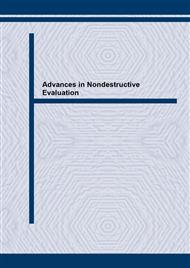[1]
Ashok Saxea: Nonlinear Fracture Mechnics for Engineer (1998), CRC Press.
Google Scholar
[2]
M.A. Frisel: NDT International Vol. 19 (1986), p.203.
Google Scholar
[3]
B.C. Morgan and R. Tilley: NDT & E International Vol. 32 (1999), p.167.
Google Scholar
[4]
E. Esmail and I. Grabec: Ultrasonics Vol. 16 (1978), p.87.
Google Scholar
[5]
B. Tomkins and J. Wareing: Mater. Sci. Vol. 13 (1977), p.414.
Google Scholar
[6]
K. Sadananda and A.K. Vasudevan: Int. J. Fatigue Vol. 19 (1997), pp. S183.
Google Scholar
[7]
K. Sanananda: Nuclear Eng. and Design Vol. 83 (1984), p.303. elastic creep zone creep zone elastic creep zone elastic Small Scale Creep Steady State Creep Extensive Creep Fig. 8. Development of creep condition with crack growth.
DOI: 10.1007/978-94-017-2444-9_12
Google Scholar


